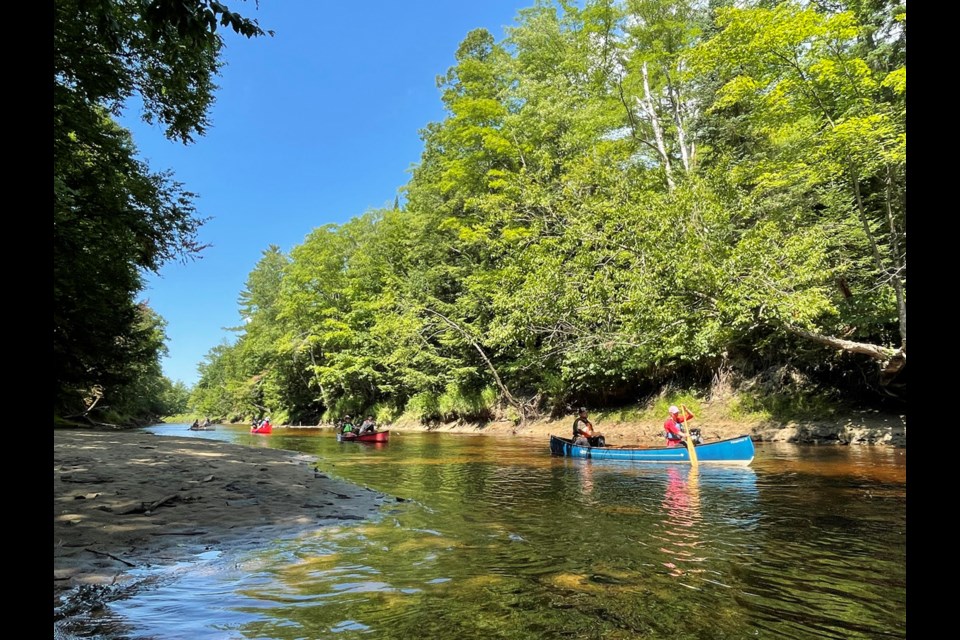What better way to try out a new canoe route than be guided by a professional biologist and joined by a group of paddling adventurers?
I always love the opportunity to explore the Black River, and was especially curious about a new boat launch from the Ron Reid Nature Reserve, so I joined a “Paddle Party” offered by the Couchiching Conservancy’s Passport to Nature program to introduce paddlers to the area.
Our guide for the day’s paddling adventure was Phil Careless, biologist for Queen Elizabeth II Wildlands Provincial Park, a wilderness park surrounding the Ron Reid Nature Reserve.
The reserve has a four-kilometre stretch of the Black River running through it, making it an ideal destination for a paddle, but with limited access points because of the rugged terrain and steep river banks.
Thanks to the ingenuity of volunteers with the Couchiching Conservancy, the “Rosebush Landing” was created, featuring a custom-made step ladder, along with a winch, to assist paddlers in launching their canoes and kayaks.
The launch is named after Joan and John Rosebush, who were major contributors in the fundraising campaign to purchase the Ron Reid Nature Reserve, and are longtime supporters of the conservancy.
Before heading upriver to Ragged Rapids, our guide gave us a brief overview of the river we were about to explore.
“This is one of the best rivers to paddle because it’s low, flat and has many sections, like the one we’re doing today, that do not have a lot of current,” explained Careless. (He was right; it was fairly easy to paddle upstream.)
“The Black is a very long river, going from Dorset all the way to Washago, about the same distance as Scarborough to Hamilton. It was used extensively by both Indigenous groups and settlers, and in the past was an active logging river,” added Careless.
In fact, the destination (and turnaround point) for our paddle — Ragged Rapids — was once the site of a logging town with 300 residents. The area was logged in the early 1800s and then, in 1913, a massive fire incinerated all the surrounding vegetation, followed by heavy rain, exposing the 3.5-billion-year-old rock barrens we see today.
“This is why you won’t see any tree over 107 years old along the river,” said Careless. “But you will see remnants of pine bark and a few large logs still stuck at the bottom of the river.”
As we made our way along the quiet and winding river, Careless explained features of the “riparian” (meaning vegetation that grows along a river) landscape, pointed out the nesting holes of kingfishers and swallows along the river bank, as well as the larger burrows made by river beavers.
One of the most interesting stops along our way was at a soft, sandy river bank where Careless told us the Black River is home to the most endangered animal in North America. To our surprise, he reached into the shallow water and pulled out a freshwater mussel.
“This is an eastern elliptio,” explained Careless, who went on to impress us with his astounding knowledge of the characteristics and life of this fascinating creature.
The species is endangered because of the historic use of garbage dumps and industry near bodies of water, as well as from invasive species like zebra mussels.
“This is your ultimate water-purification machine. These mussels work like tiny, little water-purification systems,” said Careless, explaining why it is so important to preserve the creatures.
“They act like siphon feeders, pulling water in one hole, that runs through gill-like structures before being pumped out as clean water. Mussel beds are a great way to purify water.”
The knowledge Careless was able to share with us about the river and the surrounding parkland was impressive, but it was also his obvious curiosity and fascination with the wildlife around us that was infectious. It made our paddle a true adventure in nature.
One of the paddlers in the group, John Hungate, of Orillia, said, “I can’t believe I’ve lived in Orillia all these years and didn’t know about this incredible river.”
To find Rosebush Landing, locate the Ron Reid Nature Reserve on your map or GPS system. The entry road is at the west end of the reserve off Black River Road, past Lewisham Road, and about eight kilometres from the turn-off from Coopers Falls Road. Once launched, you can paddle east to Ragged Rapids or west toward Chisholm Trail and Washago.
